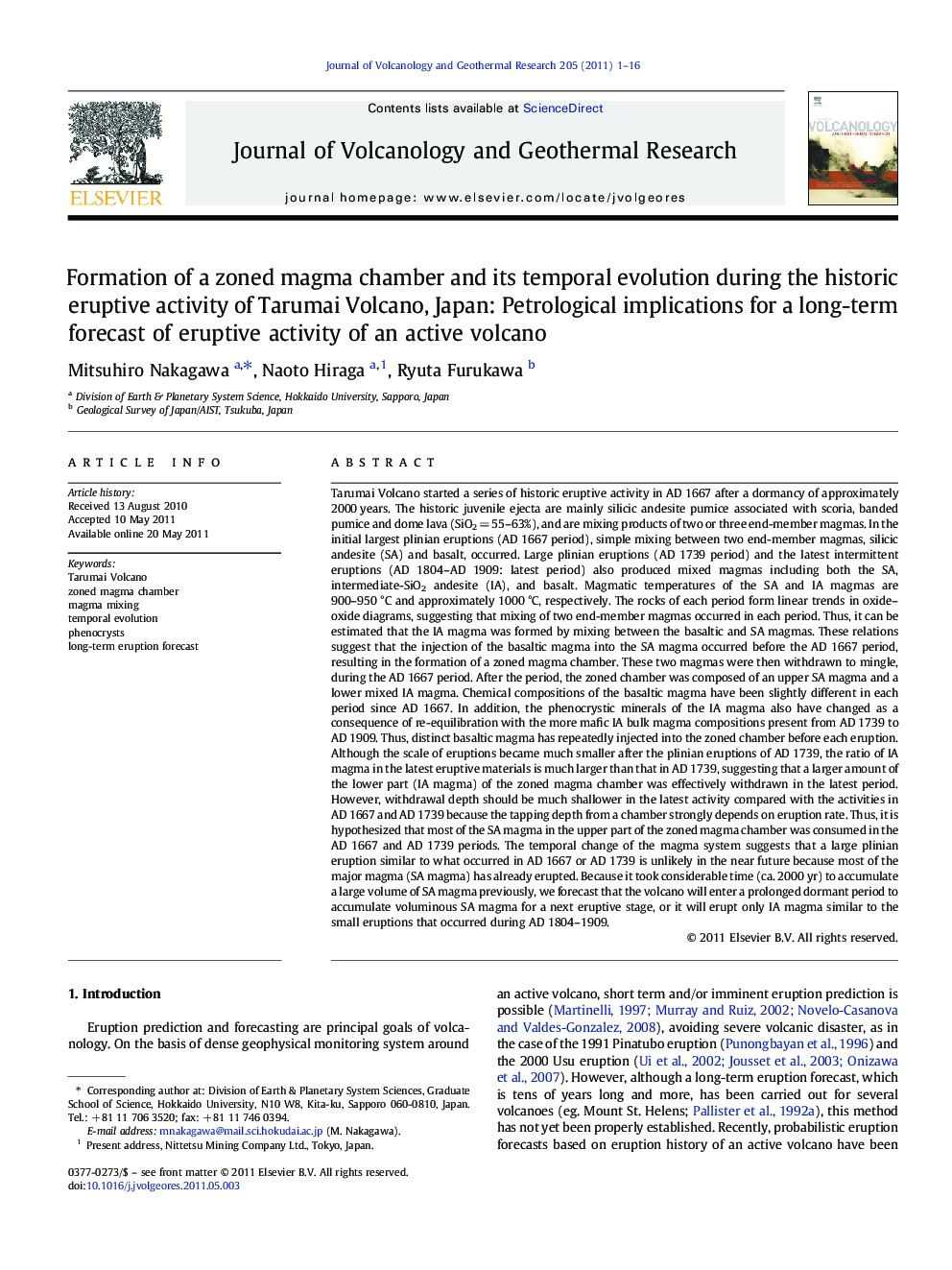| کد مقاله | کد نشریه | سال انتشار | مقاله انگلیسی | نسخه تمام متن |
|---|---|---|---|---|
| 4713896 | 1638400 | 2011 | 16 صفحه PDF | دانلود رایگان |

Tarumai Volcano started a series of historic eruptive activity in AD 1667 after a dormancy of approximately 2000 years. The historic juvenile ejecta are mainly silicic andesite pumice associated with scoria, banded pumice and dome lava (SiO2 = 55–63%), and are mixing products of two or three end-member magmas. In the initial largest plinian eruptions (AD 1667 period), simple mixing between two end-member magmas, silicic andesite (SA) and basalt, occurred. Large plinian eruptions (AD 1739 period) and the latest intermittent eruptions (AD 1804–AD 1909: latest period) also produced mixed magmas including both the SA, intermediate-SiO2 andesite (IA), and basalt. Magmatic temperatures of the SA and IA magmas are 900–950 °C and approximately 1000 °C, respectively. The rocks of each period form linear trends in oxide–oxide diagrams, suggesting that mixing of two end-member magmas occurred in each period. Thus, it can be estimated that the IA magma was formed by mixing between the basaltic and SA magmas. These relations suggest that the injection of the basaltic magma into the SA magma occurred before the AD 1667 period, resulting in the formation of a zoned magma chamber. These two magmas were then withdrawn to mingle, during the AD 1667 period. After the period, the zoned chamber was composed of an upper SA magma and a lower mixed IA magma. Chemical compositions of the basaltic magma have been slightly different in each period since AD 1667. In addition, the phenocrystic minerals of the IA magma also have changed as a consequence of re-equilibration with the more mafic IA bulk magma compositions present from AD 1739 to AD 1909. Thus, distinct basaltic magma has repeatedly injected into the zoned chamber before each eruption. Although the scale of eruptions became much smaller after the plinian eruptions of AD 1739, the ratio of IA magma in the latest eruptive materials is much larger than that in AD 1739, suggesting that a larger amount of the lower part (IA magma) of the zoned magma chamber was effectively withdrawn in the latest period. However, withdrawal depth should be much shallower in the latest activity compared with the activities in AD 1667 and AD 1739 because the tapping depth from a chamber strongly depends on eruption rate. Thus, it is hypothesized that most of the SA magma in the upper part of the zoned magma chamber was consumed in the AD 1667 and AD 1739 periods. The temporal change of the magma system suggests that a large plinian eruption similar to what occurred in AD 1667 or AD 1739 is unlikely in the near future because most of the major magma (SA magma) has already erupted. Because it took considerable time (ca. 2000 yr) to accumulate a large volume of SA magma previously, we forecast that the volcano will enter a prolonged dormant period to accumulate voluminous SA magma for a next eruptive stage, or it will erupt only IA magma similar to the small eruptions that occurred during AD 1804–1909.
Research Highlights
► Tarumai Volcano is one of the most active volcanoes in Japan. It is feared that a near future eruption would cause serious hazard around the volcano.
► Our petrological and geological analysis reveals that major felsic magma of the historic activity has been nearly exhausted now.
► Based on eruptive history and temporal evolution of magma system, we try to forecast long-term future eruptive activity of the volcano.
Journal: Journal of Volcanology and Geothermal Research - Volume 205, Issues 1–2, 1 August 2011, Pages 1–16